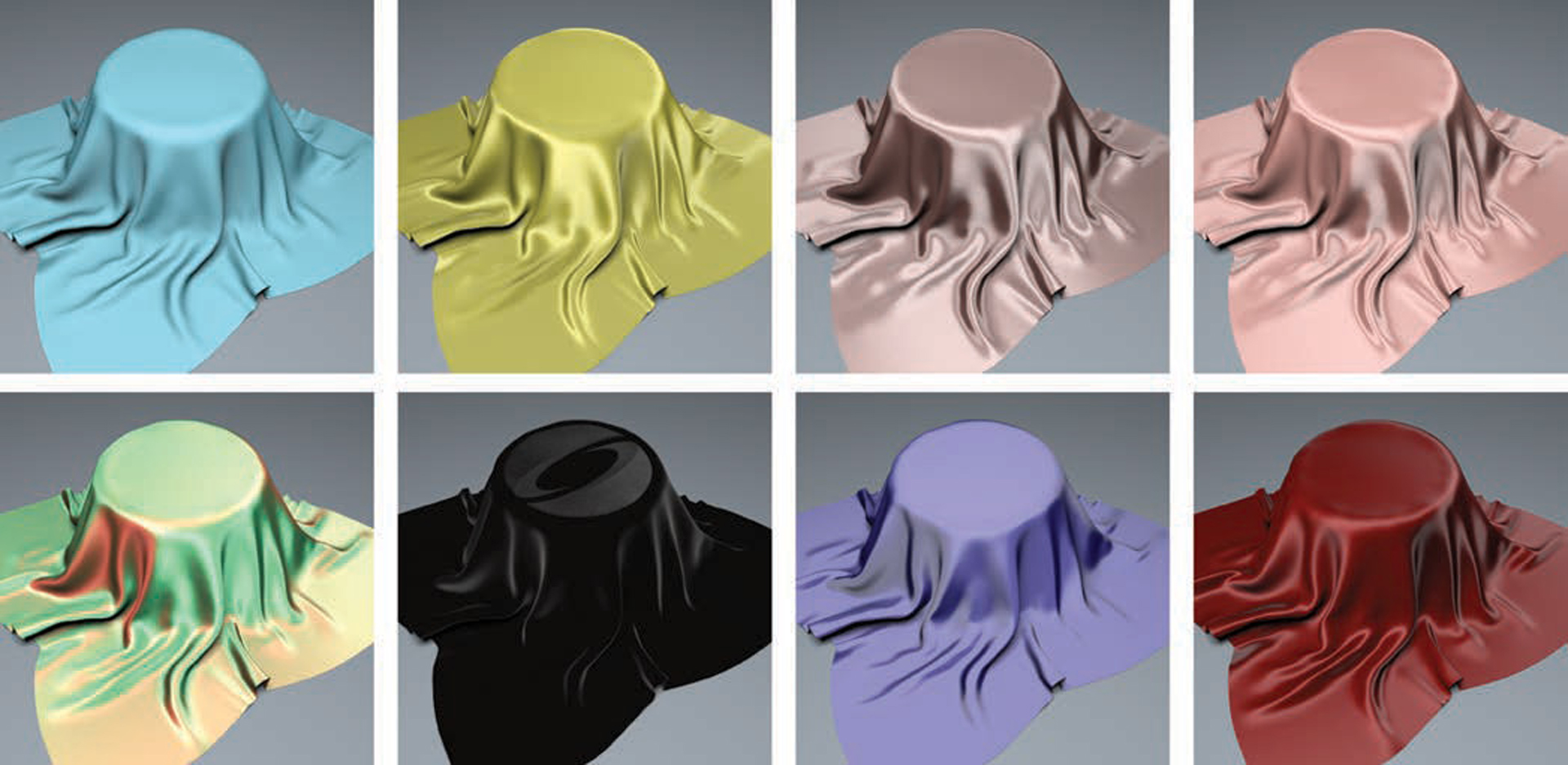“A Practical Microcylinder Appearance Model for Cloth Rendering” by Sadeghi, Bisker, Deken and Jensen
Conference:
Type(s):
Title:
- A Practical Microcylinder Appearance Model for Cloth Rendering
Session/Category Title: Materials
Presenter(s)/Author(s):
Moderator(s):
Abstract:
This article introduces a practical shading model for cloth that can simulate both anisotropic highlights as well as the complex color shifts seen in cloth made of different colored threads. Our model is based on extensive Bidirectional Reflectance Distribution Function (BRDF) measurements of several cloth samples. We have also measured the scattering profile of several different individual cloth threads. Based on these measurements, we derived an empirical shading model capable of predicting the light scattering profile of a variety of threads. From individual threads, we synthesized a woven cloth model, which provides an intuitive description of the layout of the constituent threads as well as their tangent directions. Our model is physically plausible, accounting for shadowing and masking by the threads. We validate our model by comparing predicted and measured light scattering values and show how it can reproduce the appearance of many cloth and thread types, including silk, velvet, linen, and polyester. The model is robust, easy to use, and can simulate the appearance of complex highlights and color shifts that cannot be fully handled by existing models.
References:
- Adabala, N., Magnenat-Thalmann, N., and Fei, G. 2003. Visualization of woven cloth. In Proceedings of the 14th Eurographics Workshop on Rendering (EGRW’03). 178–185.
- Ashikhmin, M., Premoze, S., and Shirley, P. 2000. A microfacet-based brdf generator. In Proceedings of the 27th Annual Conference on Computer Graphics and Interactive Techniques (SIGGRAPH’00). ACM Press/Addison-Wesley, 65–74.
- Ashikhmin, M. V. 2001. Approximate methods for improving surface appearance. Ph.D. thesis AAI3012256.
- Chandrasekhar, S. 1960. Radiative Transfer. Dover Publications.
- Chen, Y., Lin, S., Zhong, H., Xu, Y.-Q., Guo, B., and Shum, H.-Y. 2003. Realistic rendering and animation of knitwear. IEEE Trans. Vis. Comput. Graph. 9, 1, 43–55.
- Daubert, K., Lensch, H. P. A., Heidrich, W., and Seidel, H.-P. 2001. Efficient cloth modeling and rendering. In Proceedings of the 12th Eurographics Workshop on Rendering Techniques. Springer, 63–70.
- Drago, F. and Chiba, N. 2004. Painting canvas synthesis. Vis. Comput. 20, 5, 314–328.
- Glumac, R. and Doepp, D. 2004. Generalized approach to rendering fabric. In ACM SIGGRAPH Sketches. ACM Press, New York.
- Hanrahan, P. and Krueger, W. 1993. Reflection from layered surfaces due to subsurface scattering. In Proceedings of the 20th Annual Conference on Computer Graphics and Interactive Techniques (SIGGRAPH’93). ACM Press, New York, 165–174.
- Irawan, P. and Marschner, S. 2012. Specular reflection from woven cloth. ACM Trans. Graph. 31, 1, 11:1–11:20.
- Jakob, W., Arbree, A., Moon, J. T., Bala, K., and Marschner, S. 2010. A radiative transfer framework for rendering materials with anisotropic structure. ACM Trans. Graph. 29, 53:1–53:13.
- Kajiya, J. T. and Kay, T. L. 1989. Rendering fur with three dimensional textures. In Proceedings of the Annual Conference on Computer Graphics and Interactive Techniques (SIGGRAPH’89). ACM Press, New York, 271–280.
- Kim, T.-Y. 2002. Modeling, rendering and animating human hair. Ph.D. thesis, University of Southern California, Los Angeles, CA.
- Marschner, S. R., Jensen, H. W., Cammarano, M., Worley, S., and Hanrahan, P. 2003. Light scattering from human hair fibers. ACM Trans. Graph. 22, 3, 780–791.
- Marschner, S. R., Westin, S. H., Arbree, A., and Moon, J. T. 2005. Measuring and modeling the appearance of finished wood. ACM Trans. Graph. 24, 3, 727–734.
- Pont, S. C. and Koenderink, J. J. 2003. Split off-specular reflection and surface scattering from woven materials. Appl. Opt. 42, 8, 1526–1533.
- Poulin, P. and Fournier, A. 1990. A model for anisotropic reflection. In Proceedings of the 17th Annual Conference on Computer Graphics and Interactive Techniques (SIGGRAPH’90). ACM Press, New York, 273–282.
- Sadeghi, I., Pritchett, H., Jensen, H. W., and Tamstorf, R. 2010. An artist friendly hair shading system. ACM Trans. Graph. 29, 56:1–56:10.
- Saville, B. P. 1999. Physical Testing of Textiles. CRC Press.
- Schroder, K., Klein, R., and Zinke, A. 2011. A volumetric approach to predictive rendering of fabrics. Comput. Graph. Forum 30, 4, 1277–1286.
- Wang, J., Zhao, S., Tong, X., Snyder, J., and Guo, B. 2008. Modeling anisotropic surface reflectance with example-based microfacet synthesis. In ACM SIGGRAPH Papers. ACM Press, New York, 41:1–41:9.
- Weil, J. 1986. The synthesis of cloth objects. In Proceedings of the 13th Annual Conference on Computer Graphics and Interactive Techniques (SIGGRAPH’86). ACM Press, New York, 49–54.
- Westin, S. H., Arvo, J. R., and Torrance, K. E. 1992. Predicting reflectance functions from complex surfaces. Comput. Graph. 26, 2, 255–264.
- Xu, Y.-Q., Chen, Y., Lin, S., Zhong, H., Wu, E., Guo, B., and Shum, H.-Y. 2001. Photorealistic rendering of knitwear using the lumislice. In Proceedings of the 28th Annual Conference on Computer Graphics and Interactive Techniques (SIGGRAPH’01). ACM Press, New York, 391–398.
- Yang, L. 2009. Cse 348b final project: Cloth rendering. https://graphics. stanford.edu/wikis/cs348b-09/lfyg/Final_Project_Writeup/.
- Yasuda, T., Yokoi, S., Toriwaki, J.-I., and Inagaki, K. 1992. A shading model for cloth objects. IEEE Comput. Graph. Appl. 12, 15–24.
- Zhao, S., Jakob, W., Marschner, S., and Bala, K. 2011. Building volumetric appearance models of fabric using micro ct imaging. ACM Trans. Graph. 30, 4.




